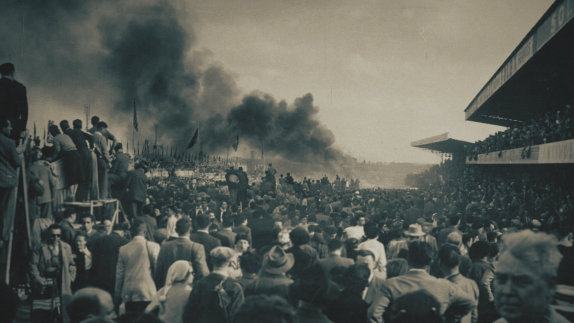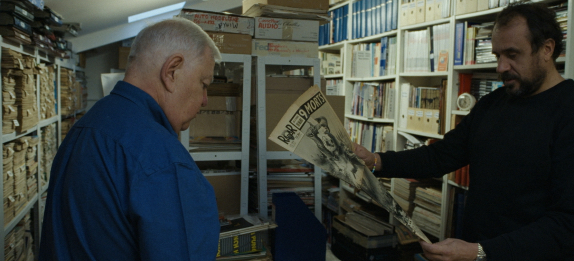…On the evening of June 18, 2005, I stood at the gate of the Le Mans circuit at the Tertre Rouge bend, and multi-colored racing cars sped past – from Audi, Pescarolo and Courage sports prototypes of the LMP1 and LMP2 classes to countless Ferraris, Porsches, Chevrolet Corvettes and Aston Martins, more moderate GT categories.
It was the same “hour of unprecedentedly hot sunset” that the classic mentioned in a completely different context, for even closer to eight o’clock in the evening it was stuffy and the thermometer, if I had had one, would hardly have read less than 30 . degrees.
It was probably the fourth or fifth hour of the famous marathon, about which I had read so much since childhood in the domestic magazine ‘Behind the Wheel’ and not only in it, and now I found myself on the French ring of Sarthe, where photographer Vitas Cherniauskas and I (a great professional by the way) were sent by the editorial office where we worked at the time.
When about a few meters away from us, as we exited the bend, a white Audi R8 sports prototype sped past, accelerating, and it seemed as if the entire surrounding space was vibrating with the roar of its mighty V8 turbo engine. It is not so easy to convey the emotions in words, a kind of boundless pleasure that gripped me, because you were not only affected by the visual and sound range: you just physically felt how at that moment an elastic wave of hot air rushes in, almost forcing you to take a step back despite your will…
Probably something similar is felt by a person who violates all safety norms near the railway lines when a high-speed train flies by. Even behind the reliable concrete fence you could feel this dangerous force, which the tough guys behind the wheel apparently tame with ease.
Within moments the car disappeared into the dusk, leaving behind in the disturbed air a complex mix of smells of hot metal, hot oil, rubber and exhaust fumes, and then the next one hit this air…
We inveterate racing romantics didn’t think much about the fact that this power was actually dangerous, although we seemed to understand it on a subconscious level. But we definitely didn’t have time for that, because an old dream had come true: we are here in Le Mans! This became a real holiday for us, but also for the hundreds of thousands of fans who come to this marathon every year, which first took place in 1923, more than a hundred years ago.
But motorsport also has a dark side, because there are stories whose heroes, unlike us, have absolutely no time for romance, and exactly such a story is told in the documentary film by French director Emmanuel Reyet ‘Le Mans 55 ‘, which is currently being released. released in Russia on October 10.
Anyone at least generally familiar with the history of world motor racing knows that the 24-hour marathon, which took place from June 11 to 12, 1955, saw a tragedy the likes of which has never occurred on racing circuits before or since. .
In the third hour of the race, to be precise, at 6:20 p.m., due to a complex and extremely unfortunate set of circumstances, an accident occurred that led to the deaths of 83 spectators, and at least 120 more people suffered injuries, burns and injuries. other injuries of varying severity.
French racer Pierre Levegh, driving a Mercedes 300SLR, was also killed – it was his car, after a collision on the start-finish straight with the Austin-Healey of Britain’s Lance McLean, which went airborne and fell upon the crowd. spectators stand to the left of the track.
McLean’s car ended up in the path of Mercedes because he was overtaken by the Jaguar of Mike Hawthorn, the future world champion, who had already driven for Ferrari in Formula 1 that year. Just passing would have been nice, but Hawthorne immediately started braking because he had to make a pit stop. To avoid the slower Jaguar, McLean swerved sharply to the left at high speed, at which point contact occurred between his Austin-Healey and Levegh’s Mercedes.
What followed is indescribable, and I won’t even try, if only because it is all analyzed in detail in Reye’s film. But ‘Le Mans 55’ is not even about the accident itself, even though the story is built around it, but about its consequences, about the scars it left in the souls of people who lost their loved ones on June 11 of that year .

Among the victims of the accident were the uncles of the author of the film – then very young boys, Claude and Francois Reyet. Emmanuel never saw them, moreover, he only learned about the circumstances under which they died when he was about 17 years old, and even then not from his family, but from strangers. It turned out that the Reine family kept a certain secret for many years, which, having already become a famous film producer and director, he decided to find out 68 years after that tragedy in Le Mans.
His film is an investigation by the author, where he meets older relatives, but also friends and acquaintances of the family, who might somehow know something about the accident. Having collected their memories, he immediately discovered many contradictions in them and tried to restore the true picture of what happened, for which he turned to the archives of the ACO car club, the organizer of the race, and unexpectedly on a categorical refusal met.
Attempts to find anything in the local municipal archives of the Sarthe department were also unsuccessful – it turned out that access to all materials related to the accident and its consequences was closed. All information will be kept secret for 75 years, and this ban should not be lifted until 2031. It seems that this is not a military secret, and not some kind of state secret. So why limit access to those historical documents?
This did not stop Emmanuel Reyet, he continued his search, met many journalists, representatives of different countries, who over the years worked on books about Le Mans and the 1955 accident. He even managed to contact the Brazilian Hermano da Silva Ramos, the only racer who took part in that marathon and managed to survive to this day. But as the investigation continued, the mysteries multiplied.

In general, I recommend everyone who is interested in motorsports not to miss this film – personally, once was not enough for me, I have already watched it twice. Because Emmanuel Reyer talks about that side of racing that is usually hidden from fans and sometimes surrounded by such secrets that it is difficult to unravel them even now.
If I had known then, in 2005, what this film was about, I would somehow have perceived the events that unfolded before my eyes at the Circuit de la Sarthe differently. But the film has only just been released; it is completely new, even though it tells about events that took place almost 70 years ago. But he puts it this way that you want Emmanuel Reyet to direct a sequel. Although it seems that access to the archives will not open anytime soon.
…In 1955, the Le Mans race lasted all 24 hours, despite the absolutely terrible tragedy that claimed so many lives, and Hawthorne won the race, even uncorking a bottle of champagne after the finish. Why weren’t the competitions stopped immediately, because from today’s perspective the race management’s decision to continue the marathon to the bitter end seems downright cruel? Reye’s film provides an answer to this question.
Source: F1 News
I am Christopher Clyde, an experienced journalist and content writer with a passion for sports. I have been writing about Formula 1 news for the past five years and am currently employed as an author at athletistic.com, one of the top sports websites in the US.


